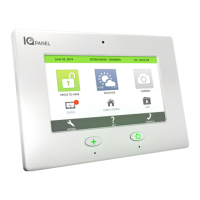How to hard reboot QOLSYS IQ PANEL Control Panel?
- HhaleymarySep 13, 2025
To perform a hard reboot on your QOLSYS Control Panel, press and hold the “Home” button for 30 seconds.

How to hard reboot QOLSYS IQ PANEL Control Panel?
To perform a hard reboot on your QOLSYS Control Panel, press and hold the “Home” button for 30 seconds.
| Display | 7-inch touchscreen |
|---|---|
| Resolution | 1024 x 600 |
| Communication | Wi-Fi, Cellular |
| Sensors | Built-in Accelerometer |
| Voice Control | Yes (Amazon Alexa, Google Assistant) |
| Z-Wave | Yes (Z-Wave Plus) |
| Bluetooth | Yes |
| Battery Backup | Rechargeable lithium-ion battery |
| Siren | 85dB internal siren |
| Wireless Connectivity | Wi-Fi, Z-Wave, Bluetooth |
| Security | Encrypted Sensors, Tamper Detection |
Details the components visible on the front of the IQ Panel, including camera, screen, and buttons.
Describes the components located on the back of the IQ Panel, such as mounting holes and ports.
Explains the three main sections of the home screen: header, primary interface, and footer.
Explains the color coding of the header bar based on system status (Ready, Not Ready, Armed).
Explains how to use the '+' emergency button to access police, fire, and auxiliary alarms.
Guides users on selecting emergency types and silencing the siren for fire/auxiliary alarms.
Details the process for canceling an accidental emergency activation, requiring a user code.
Describes how Police, Fire, and Auxiliary alarms are triggered and activate Two-Way Voice.
Provides guidance on disarming the system and communicating with monitoring agents during false alarms.
Details how triggering Police, Fire, or Auxiliary panic buttons initiates specific alarm responses.
Explains the differences between 'Stay' and 'Away' arming modes and their sensor activation.
Describes how to bypass individual sensors to arm the system with open points.
Explains how to disarm the panel using a user code, including delay countdowns.
Describes the 'Quick Exit' feature for temporary door access while the system is armed.
Describes how to manage thermostats, smart sockets, door locks, lights, and other connected devices.
Covers the need for a Master Code and details on the default master code.
Explains how to add, edit, or delete user codes and manage access levels.
Details various tests like Wi-Fi, Sensor, Cellular, and Panel tests for system upkeep.
